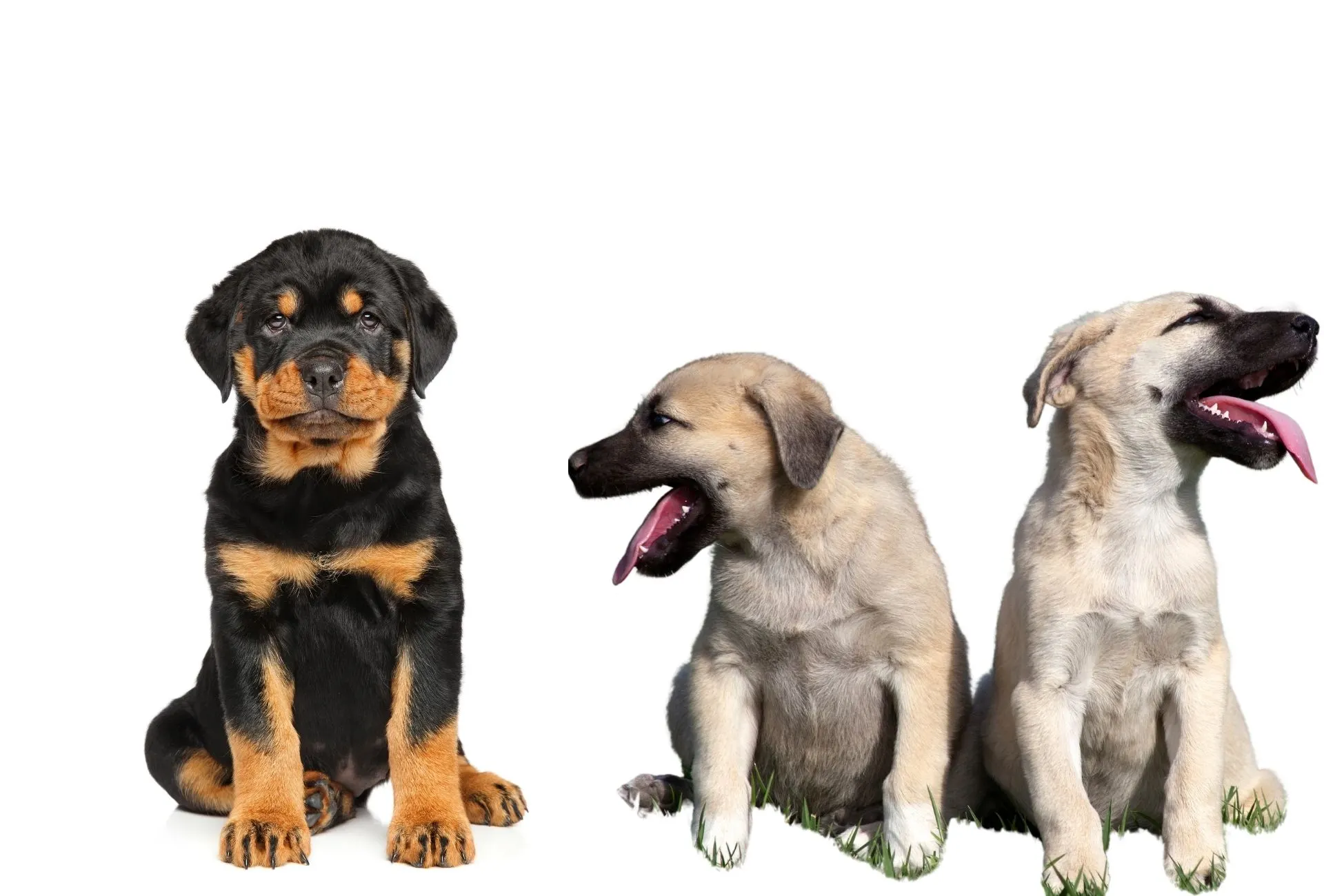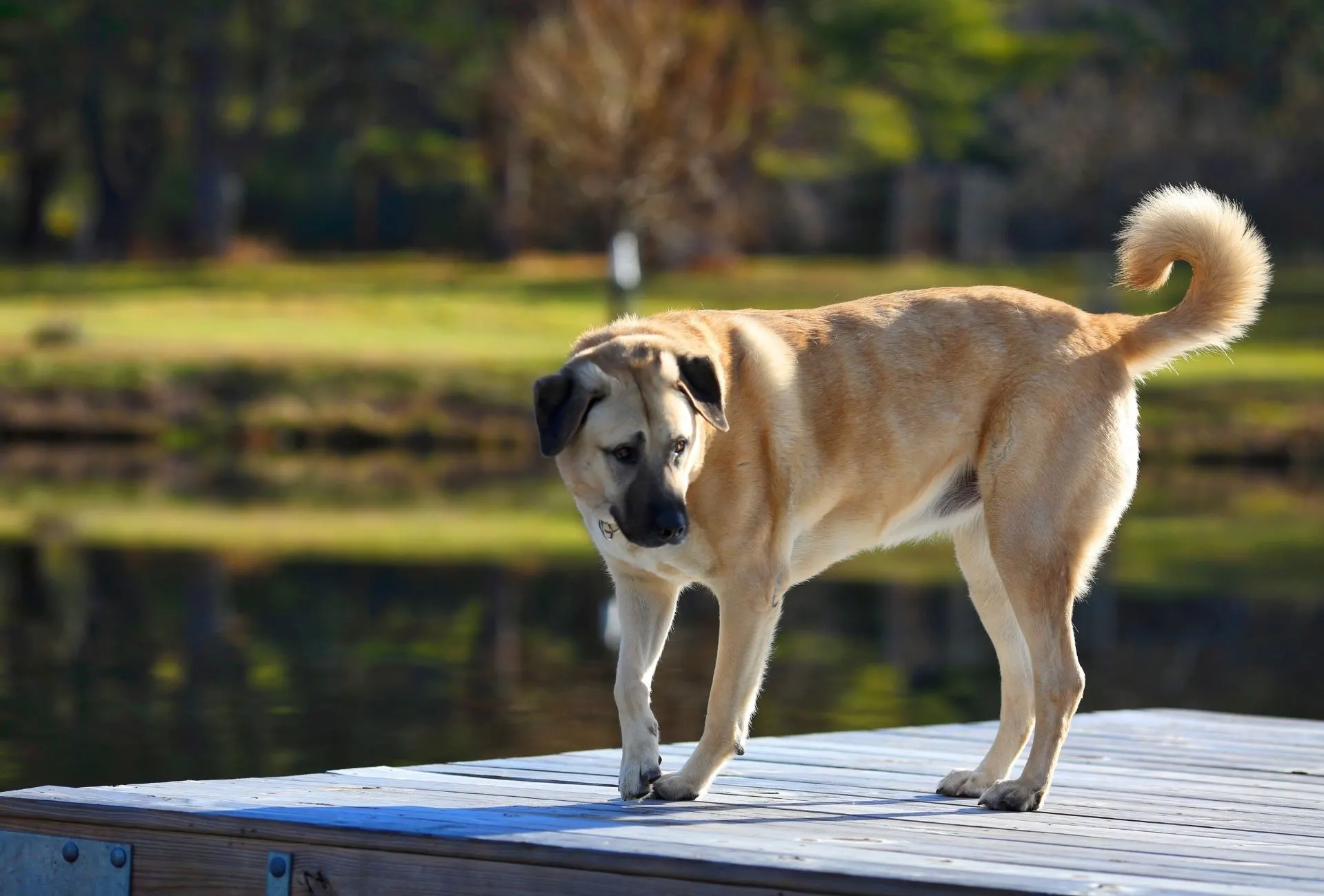Rottweilers and Kangals originate from two distant places on the planet.
It may seem that these two breeds have little in common, but the fact is that they have many similarities and can perform the same tasks.
Kangals originate from the Anatolia region in Turkey.
Despite Kangals being slightly larger than Rottweilers, the Rottie makes up for it by bringing a massive weight if you take their athletic frame and height into consideration.
Kangals range from 25-31.5 inches (63-80 cm) in height with an approximate weight of 90-150 lbs (41-66 kg).
The smaller competitor, the Rottweiler comes from Germany.
Male individuals stand between 24-27 inches (61-69 cm) and weigh 110 to 130 lbs (50-60 kg).
Females are 2 inches (5 cm) shorter and their weight range is 77-110 lbs (35-48 kg).
Both dog breeds are fierce protectors of what they consider to be their own or part of their pack.
Rottweilers are more of family/house protectors while Kangals are better at protecting farms and livestock – in reverse setting both breeds can perform well.
Without early socialization and proper introduction to strangers, both dogs can become highly confrontational.
That’s not a desired trait because these breeds are big and hard to handle.
How is Bite Force Measured in Rottweilers and Kangals?
The bite force in Rottweilers and Kangals is measured either by electrical stimulation of the jaw adductor muscles in anesthetized dogs or by calculating the forces produced by the anatomical structures responsible for biting by using mechanical equations.

The bite force is simply the power used to put the jaw on something or someone.
In dogs, the unit for measuring this power is called PSI (Per Square Inch).
This scientific unit is used to describe the pressure applied by one pound to a surface of 1 square inch.
Sometimes it’s also referred to as pound-force per square inch or just pound per square inch.
In Vivo Studies of Bite Force in Dogs
There are few in vivo studies that tested the bite force in anesthetized dogs by using electrical stimulation of the muscles.
In one the test was performed on three breeds considered to have the possibility to cause great damage with their jaws – German Shepherds, Pit Bull Terriers, and Rottweilers.
The Rottweilers had the strongest bite of all three, but this test can’t be considered completely accurate because some factors affect the biting force, but cannot be implemented in the testing:
- The stimulation of the muscles can’t produce maximum voluntary contraction
- Lack of chewing enthusiasm in the awake dog
- Lack of awake personality in the testing
If you’re wondering why no one uses wake dogs to test the biting force it’s because canines don’t know you are asking them to bite with all they have.
The in vivo studies only proved a positive correlation between the dog’s size and the biting force.
In Vitro Studies of Bite Force in Dogs
The most accurate and widely used numerical tool for solving complex problems in animal biomechanics is the FEA (Finite Element Analysis).
FEA allows clarification of the bite force by building, loading, and validating the skeletal models via a computer system.
Factors that affect the bite force in dogs and humans are:
- Skull size (bigger size-stronger bite)
- Skull shape
- Oral pain and periodontal disease
- Osteoarthritis
- Malocclusion
- Myositis
Brachycephalic breeds tend to have a higher bite force compared to dolichocephalic dogs, except for the small brachycephalic breeds and dogs with extremely malformed skull shapes.
Naturally, any health problem affecting the teeth, the mouth, the joints, and the muscles can negatively affect the bite force because of the corresponding pain and discomfort.
Rottweiler Bite Force
Rottweilers have a calculated 328 PSI bite force. This is almost twice the power their body weight applies on a surface. Rottweilers are considered to have the second strongest “locking” bite amongst all dog breeds (Pit Bull Terriers being the first).

The locking bite or the locking mechanism of the jaw in dogs is just a great myth. Their hinge joints holding the jaw allow the mouth to close and open all the time.
No ratchet mechanism would just lock the jaw in place, there’s no such thing as true locking in canines.
Why exactly Rottweilers are credited with being part of the locking jaw family of dogs is because of their enthusiasm when biting.
Their strong determination is just a behavioral trait that helps them hold on to something they bite to cause more harm and thus eliminate the threat.
Rottweilers rank 12th on the strongest bite force dog scale.
A bit higher than them are the Leonberger and the Japanese Akita Inu with 399 and 400 PSI respectfully and the Siberian Husky ranks one step below with 320 PSI.
Dogo Argentino and Dogo Canario have around 500 PSI while the Bandog’s and Cane Corso’s bite force is almost as twice as strong as the Rottweiler’s.
Myths on Rottweiler bite force
For a long time, there has been a myth that the bite force of Rottweilers is 2000 pounds per square inch (PSI).
This information was repeatedly mentioned at dog behavior conferences and it even spread among the veterinarian community.
Today we know that the bite force of Rottweiler dogs is far less than 2000 PSI, but how did the misinformation even occur in the first place?
Probably traces back to an experimental work done at the Guelph University of Canada and published in the Journal of Anatomy back in 2008.
The team used in vivo and in vitro methods and concluded that the bite force is different in the front portion and back portion of the jaw.
The back portion produced pressure of around 568 pounds compared to the 170 pounds in the front.
Still, that’s a long way from 2000 PSI.
The results, however, in this particular research were presented in Newtons instead of PSI.
The average bite strength of the dogs in the study does come out to be around 2000 Newtons and that’s probably how the myth came to life.
A Newton equals 0.22 pounds of force, so 2000 Newtons equals around 450 PSI, which is close to the actual bite force of Rottweilers.
Kangal Bite Force
With an amazing bite force of 743 PSI, the Kangal claims the number one spot on the dog bite force scale. That’s almost more than twice the bite strength of Rottweilers and 3 times stronger than the Doberman Pinscher.

Although Kangals can cause the most damage of all the dogs out there they are surprisingly pretty stable, especially around children.
They do require intensive training and if done right you will end up with one incredibly strong companion.
Kangal Bite Force Compared to Wild Animals and Humans
The bite of the wolf is one of the most feared forces in nature.
They have very strong jaws and sharp teeth that enable them to hurt their prey and other predators.
Wolfs are probably the biggest threat to Kangals and the livestock they are protecting.
A test performed by National Geographic revealed a bite force of 406 PSI from a specimen that’s strong and big.
However other recordings performed shown that a wolf’s bite can reach up to 500 and even 600 PSI.
Even though that’s a lot, it’s still no match for the Kangal’s biting force.
The Jaguar can produce the strongest bite with amazing 1500 PSI among all the cats.
The Bengal tiger comes second with 1050 PSI and the king of the jungle, the Lion has a bite force of around 650 PSI.
The Great White Shark and the Saltwater Crocodile are the animals with the strongest bite force of around 3700-4000 PSI on the planet.
Humans have a biting force of roughly 160-165 PSI because our survival doesn’t depend on our biting force, but that’s not the case with wild dogs and cats.
So Who Has The Strongest Bite – Kangals or Rottweilers?
The Rottweilers 328 PSI is no match for the powerful biting force of the 743 PSI Kangal has. The only thing that adds a spice of danger to the Rottweiler is his amazing determination responsible for the jaw lock behavior.
Both breeds are very hardworking and very courageous.
They can work relentlessly for long hours and cause severe damage to humans and other animals if they feel the need to attack or protect.
When do Rottweilers and Kangals Bite with the Biggest Force?
If your dog is in full health, he will produce his strongest bite if he is in a life or death situation. Dogs aren’t natural killers and don’t have the intention of hurting anyone or anything except when their lives or the lives of their closest are in danger.
They will sometimes bite just enough to scare the opponent without causing big injuries.
However, in cases when they are seriously cornered and/or outnumbered and see no other way, they will put the full force of their jaws to use.
Disclaimer: This blog post does not substitute veterinary attention and does not intend to do so. I am not a veterinarian or pet nutritionist. If your dog shows any sign of illness, call your vet.
Eric
Friday 13th of May 2022
I don't know how many tests were done on these Rotties or the size of them or training involved however I have been training in shutzhund for 35 years we've had several very large Rotties using a gnathodynamometer for several weeks consistently bitting on a good back jaw lock at over 1000 psi on average i truly believe its the individual dog it always upsets me when I see them at 325 psi on average its just not true.
Anti-BS Police
Tuesday 12th of September 2023
@Eric,
Locking jaws and 1000 psi bite force wow what a trip to fantasy land a made up propaganda. No such thing as a jaw lock or locking jaw. Terms only used by the ignorant.
1000psi is in the realm of the spotted hyenas and brown bears polar bears. The very fact you stare it upsets you to see a number that is j line with all other canine numbers based on jaw structure size and mus le mass shows your ego is what is fully engaged. Why would it upset you? Why would it e en matter. S So exactly when doid IPO or any dog trainers start using Gnathodynamometervas standard equipment. I call total BS.
Danielle
Thursday 19th of May 2022
Hey Eric, I've heard about these instances but unfortunately, there's rarely any proof behind that claim. If you do have a video of that, please feel free to send that over.
I've also seen DIY tools to measure and they were in fact pretty high considering that their bite force wasn't fully applied but that's not saying much if it's not ensured that the device works properly and was tested on other breeds as well.
Cheers, Danielle